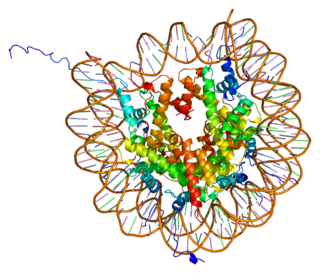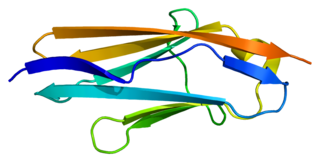
The activin A receptor also known as ACVR1C or ALK-7 is a protein that in humans is encoded by the ACVR1C gene. ACVR1C is a type I receptor for the TGFB family of signaling molecules.

Histone H2B type 3-B is a protein that in humans is encoded by the HIST3H2BB gene.

Engulfment and cell motility protein 1 is a protein that in humans is encoded by the ELMO1 gene. ELMO1 is located on chromosome number seven in humans and is located on chromosome number thirteen in mice.

Microtubule-associated proteins 1A/1B light chain 3A is a protein that in humans is encoded by the MAP1LC3A gene. Two transcript variants encoding different isoforms have been found for this gene.

Integrin beta-1-binding protein 1 is a protein that in humans is encoded by the ITGB1BP1 gene.

Cytoplasmic linker associated protein 1, also known as CLASP1, is a protein which in humans is encoded by the CLASP1 gene.

Serine/threonine-protein kinase PLK2 is an enzyme that in humans is encoded by the PLK2 gene.

CAMP responsive element binding protein-like 1, also known as CREBL1, is a protein which in humans is encoded by the CREBL1 gene.

Zinc transporter SLC39A7 (ZIP7), also known as solute carrier family 39 member 7, is a protein that in humans is encoded by the SLC39A7 gene. Its fruit fly orthologue is Catsup.

Autophagy related 12 is a protein that in humans is encoded by the ATG12 gene.

Striated muscle preferentially expressed protein kinase, in the human is encoded by the SPEG gene, a member of the myosin light chain kinase protein family. SPEG is involved in the development of the muscle cell cytoskeleton, and the expression of this gene has important roles in the development of skeletal muscles, and their maintenance and function. Mutations are associated with centronuclear myopathies a group of congenital disorders where the cell nuclei are abnormally centrally placed.

Serine/threonine-protein kinase 38-like is an enzyme that in humans is encoded by the STK38L gene.

Calcium-binding protein 39 is a protein that in humans is encoded by the CAB39 gene.

Aftiphilin is a protein that in humans is encoded by the AFTPH gene. It forms a stable complex with p200 and synergin gamma. It contains a clathrin box with two known clathrin-binding sequence motifs, is involved in vesicle trafficking and is found in many eukaryotes.

ULK1 is an enzyme that in humans is encoded by the ULK1 gene.
AuTophaGy related 1 (Atg1) is a 101.7kDa serine/threonine kinase in S.cerevisiae, encoded by the gene ATG1. It is essential for the initial building of the autophagosome and Cvt vesicles. In a non-kinase role it is - through complex formation with Atg13 and Atg17 - directly controlled by the TOR kinase, a sensor for nutrient availability.

Autophagy-related protein 101 also known as ATG101 is a protein that in humans is encoded by the C12orf44 gene.

Centrosomal protein of 164 kDa, also known as CEP164, is a protein that in humans is encoded by the CEP164 gene. Its function appears two be twofold: CEP164 is required for primary cilium formation. Furthermore, it is an important component in the response to DNA damage by UV light.

Centrosomal protein of 76 kDa, also known as CEP76, is a protein that in humans is encoded by the CEP76 gene.

Phosphoinositide 3-kinase regulatory subunit 4, also known as PI3-kinase regulatory subunit 4 or PI3-kinase p150 subunit or phosphoinositide 3-kinase adaptor protein, or VPS15 is an enzyme that in humans is encoded by the PIK3R4 gene.















